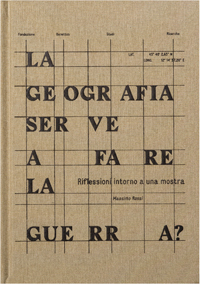
La geografia serve a fare la guerra?
Riflessioni intorno a una mostra
[Is the purpose of geography to make war? Reflections on an exhibition]
by Massimo Rossi
Fondazione Benetton Studi Ricerche-Antiga Edizioni
Treviso 2016, 151 pages, 35 colour illustrations
cover price: Euro 25.00, ISBN 978-88-99657-53-6
The monograph resumes and develops the themes explored in the exhibition of the same name, held by the Fondazione Benetton Studi Ricerche, and mounted in partnership with Fabrica at the Spazi Bomben, Treviso, 6 November 2016-19 February 2017.
The pretext for this book is the centenary of the Great War, which only became the “First World War” after the Second had established the sequence, and which in the narratives of its protagonists immediately assumed the adjective calculated to underline its utter disproportion from all previous wars. More precisely it is a pretext to reflect on the meaning and utility of a particular discipline: geography.
A map is the result of a cultural workshop very attentive to composing a media message with the tools that are peculiar to it: symbols, scale, colours, place-names. Yet undoubtedly the ‘spirit of the time’ cannot but pervade also the role of the geographer, who lives and works in the same historical context in which the events take place, in this case a world war, which would modify the very nature of the places in which it was fought, re-designing them with new attributes on special ‘war maps’. Through a series of reflections and interviews with geographers, historians, anthropologists and landscape experts (Marco Aime, Piero Del Negro, Giuseppe Dematteis, Franco Farinelli, Giuseppe Gullino, Domenico Luciani, Francesco Micelli, Leonardo Rombai, and Massimo Quaini), the author investigates how a dominant school of thought came to be formed and how this influenced cartography. Maps thus became forms of propaganda, manifestoes to transmit concepts (the natural frontier, the nation) and vindicate the historical, cultural and linguistic sovereignty over territories subjected to other political entities. Together with the Zeitgeist, the cultural spirit of an epoch, the monograph also explores the maps of non-academic geographers, such as Cesare Battisti, who critically proposed other interpretations of the historical rapport between places and communities. But a map is also the result of a subtraction – the third dimension – from the globe, and may multiply its own potentialities as soon as an artist decides to dialogue with it. The book analyzes the extraordinary effectiveness of an artistic gesture capable of producing a new semantic system and a different rapport between man and image of the world. So, is the purpose of geography to make war? Like all forms of knowledge, geography is neither good nor bad: it depends on the use we make of it, because it is man who wakes war, and to achieve his objectives he is willing to use all available disciplines, so not only geography, but physics, chemistry, geometry, mathematics, history, anthropology, linguistics…
Massimo Rossi (1959), historical geographer, graduated with distinction in the faculty of humanities at the University of Ferrara and completed his doctorate in historical geography at the University of Genoa. Winner of a bursary at the Newberry Library in Chicago (1989), he worked at the Istituto di Studi Rinascimentali in Ferrara as coordinator of the Historic Archive of Cartography of the Estensi. He teaches geography of the contemporary territory at the IUAV University of Venice, Department of Project Cultures. Since 1996 he has also been in charge of the map collection of the Fondazione Benetton Studi Ricerche.
Contents of the book
Preface, by Marco Aime, 8
Acknowledgements, 12
Introduction, 17
Rocks and waters, 23
Human signs, 45
Ethnic and linguistic maps
Atlas of our war
Cesare Battisti, geographer
Geography at the peace conference
Place-names
War maps, 95
Homing pigeons
The gastronomic map of the Veneto
Reconnaissance flights, air photos and cartographic updates
War and literature
Maps and art in the exhibition, 111
What use is geography?, 125
Bibliography, 136
Cartographic and iconographic materials and works exhibited, 144
